 |
|

|
 |
TABLE of CONTENTS
 |
I-94 expansion project kicks off Corridors of Commerce program |
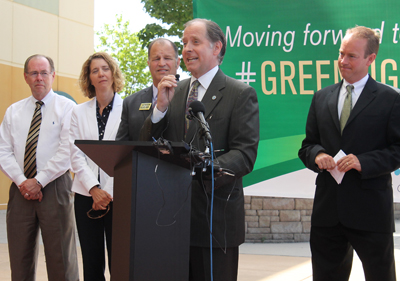
Commissioner Charlie Zelle spoke at the groundbreaking ceremony in St. Michael June 30 for the Interstate 94 Corridors of Commerce project that will reduce congestion over the Crow River between the cities of Rogers and St. Michael. Photo by Kevin Gutknecht |
Minnesota’s Corridors of Commerce program kicked into high gear June 30 with the groundbreaking of the first project, a $28.3 million expansion of Interstate 94 that will reduce congestion over the Crow River between the cities of Rogers and St. Michael.
As the first shovels hit the ground on this major project, MnDOT announced four additional projects made possible by new Corridors of Commerce funding approved in 2014 by Gov. Mark Dayton and the Minnesota Legislature.
“Transportation projects funded by the Corridors of Commerce initiative will reduce travel times, improve safety for Minnesota citizens, and help our businesses transport their products more efficiently,” said Dayton. “The number of projects from all over our state, which sought financing from this program, underscores the acute need for more transportation funding to meet the needs of our state’s growing economy.”
This year, the Legislature added $31.5 million to the Corridors of Commerce program, including $6.5 million to be used in fiscal year 2014 for projects in Greater Minnesota, and $25 million in fiscal year 2015 for projects statewide. MnDOT announced that the first $6.5 million installment will go to the following projects:
- Highway 14 ($1.5 million) for right of way to expand highway between Dodge Center and Owatonna
- Highway 23 ($1.5 million) for environmental work on future expansion from New London to Paynesville, and Paynesville to Richmond
- Highway 34 ($1.9 million) to build a center-left turn lane in Detroit Lakes from Highway 59 to County Road 141
- Highway 2 ($1.6 million) to reconstruct segment of roadway in Deer River
Commissioner Charlie Zelle joined U.S. Sen. Amy Klobuchar, U.S. Rep. Michele Bachmann, state Rep. David Fitzsimmons, state Rep. Frank Hornstein and state Sen. Mary Kiffmeyer for the I-94 groundbreaking ceremony.
“We need to take care of our transportation system, which is critical to our economy,” Zelle said. “The Corridors of Commerce program is a down payment of sorts on transportation projects that are important to Minnesota’s future and quality of life. These projects will improve traffic movement and the flow of freight, which will lead to better business and, ultimately, a stronger economy.”
MnDOT's goal is to announce the fiscal year 2015 projects in fall 2014.
Corridors of Commerce projects taking shape statewide
The Minnesota Legislature created the Corridors of Commerce program in 2013, setting aside $300 million, which became available July 1. That money will fund 10 projects, five of which will start this year. In addition to the I-94 expansion, other projects scheduled to begin this year, and their cost range in 2014, are:
- Highway 2 ($8 million to $10 million) to build passing lanes from Cass Lake to Deer River
- Highway 34 ($8 million to $10 million) to build passing lanes from Detroit Lakes to Nevis
- Highway 14 ($12 million) to build four lanes between Highway 218 to east of Steele County Road 43
- Highway 610 ($100 million) to realign and extend highway from County Road 81 and Elm Creek Boulevard to I-94
For more information on the Corridors of Commerce program, including a comprehensive list of projects being funded through this project statewide, visit www.mndot.gov/corridorsofcommerce.
|
 |
|

|
 |
TABLE of CONTENTS
 |
Travel-time systems help reduce motorists’ stress in work zones |
By Kristin Kammueller
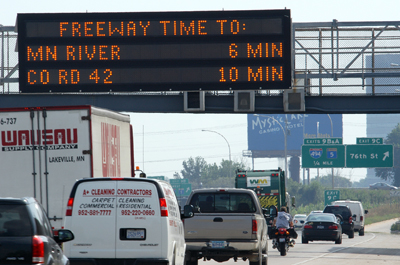
Traffic alert signs inform motorists of the delay time on freeways. The systems also provide data during construction projects to help MnDOT make estimates as to what the delays will be on similar projects around the state. Photo by David Gonzalez |
Safety and mobility have always been a part of districts’ Transportation Management Plans, but not until recently did MnDOT begin to look closer at quantifying the impact projects have on mobility and congestion.
With the help of the Office of Customer Relations, feedback was gathered from motorists regarding the traffic alert signs. The survey asked motorists to what extent they noticed the signs, if the signs were helpful, and to what extent they made decisions based on the information.
With this feedback, the Regional Transportation Management Center and Metro Traffic staff determined that motorists better tolerate being delayed by construction if they know how long the wait will be.
“Understanding that we could reduce a motorist’s stress while they sit in traffic just by telling them how long it is going to take for them to get from point A to point B has made us more effective at meeting our customer’s needs,” said Tiffany Dagon, Metro work zone engineer.
Working with project managers and RTMC in Roseville, the Office of Traffic, Safety and Technology selects projects based on how great the impact and potential delay is going to be on a person’s daily commute.
If projects with a similar average daily traffic count and the same type of work had a high impact on daily delays during construction, a travel-time system is considered. For example, the pavement improvement project on I-494 in Bloomington between Hwy 100 and Hwy 77 used the travel-time system last construction season.
“We knew this project was going to cause significant delays for commuters, so having the time-travel system included in the project not only reduced stress for the motorists, it also helped to reduce congestion because motorists were able to adjust their routes based on what the travel-time system was showing,” said Brian Kary, freeway operations engineer.
Temporary travel-time systems are strategically installed in locations prior to a decision point so the driver can make a choice of staying on the mainline, or getting off and taking an alternate route.
In addition to helping motorists make informed decisions, the travel-time system also provides data to MnDOT showing what the delays have actually been, which helps staff to make educated estimates as to what the delays will be on similar projects around the state.
The goal is to keep construction-related delays at less than 15 minutes.
“In some cases we have been surprised at what our impacts have been,” said Dagon. “There have been a couple of projects that we thought the delay would be well over 20 minutes and it turned out to be right in the 15-minute range.”
Since 2011, the travel-time system has been used on projects in District 1, District 3 and Metro District, but Dagon said the district traffic offices will continue to look at projects around the state and make recommendations when a project meets the high-impact criteria. |
 |
|

|
 |
TABLE of CONTENTS
 |
Peer Exchange: Pavement researchers face similar issues, financial pressures |
|
By Shannon Fiecke, Research Services & Library
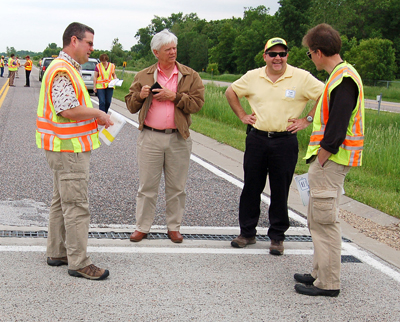
Federal and state pavement experts examine test sections at MnROAD during a peer exchange event, where they shared ideas and research experiences. Photo by Shannon Fiecke |
Soaring construction costs and a rapidly aging infrastructure will require states to revolutionize how they maintain their roadways — but without each other’s help, they won’t be successful.
That was a key message from pavement researchers last week at a MnDOT-hosted peer exchange event, where pavement experts from around North America shared their ideas and research experiences.
“You’ve got to partner with other states, the FHWA and industry,” said Steve Bower, a Michigan Department of Transportation research engineer. “We can’t go it alone anymore.”
Researchers at the event reviewed recent pooled-fund studies conducted at MnROAD, the state’s innovative pavement testing center, to review successful implementation strategies, develop common practices to calculate benefits, and help prioritize future research topics for MnROAD’s core 2016 research and reconstruction.
“The input from everyone was invaluable and will really help us hone down on what our next research efforts should be,” said Ben Worel, MnROAD operations engineer.
The pavement engineers gathered for the event face similar problems in their home states, as demonstrated by the seven pooled fund projects that were discussed, including:
MnROAD leads the way
State research departments often lack the time or resources to focus on innovations that could reduce future maintenance costs. Without Minnesota leading the effort on many of these topics and providing a top-notch research facility, the peer exchange attendees said much of this research just wouldn’t happen.
“We don’t have a closed-loop facility with all these different test sections that MnROAD has; no one does,” said Larry Wiser of the Federal Highway Administration’s Turner-Fairbank Highway Research Center.
For example, without MnROAD’s help, the Wisconsin Department of Transportation wouldn’t have been able to scientifically prove the pavement damage being done by modern farm implements, said WisDOT Chief Materials Management Engineer Steven Krebs. He said the research was necessary to combat claims to the contrary from some in the agricultural community. The state is now working with counties on possible remedies and weight limit enforcement techniques.
Where Minnesota has taken the lead on studying such issues, it is now asking fellow states to not only participate in future such studies, but to also partner in the operations at MnROAD. At the peer exchange, the response to this idea — especially from states closest to Minnesota — was positive, despite everyone’s lean budgets.
Peer exchange participants said more effort and funding is required to implement research findings, which FHWA officials noted costs significantly more than the research itself. And past research needs to be made more accessible.
They would also like to see more sharing of information between peers, particularly online.
“This (peer exchange) gave us ideas to take back. Our research budget is getting tighter. It’s nice to be able to say, ‘You do a part of it and we’ll do a part of it,’ ” said Joe Holland, California transportation researcher. |
 |
|

|
 |
TABLE of CONTENTS
 |
MnDOT safety messages go up in Target Field |
By Sue Roe

The Orange Cones, No Phones message stands out in center field at Target Field. The safety message is among those MnDOT is displaying through September as a trade with the Twins. Photo by Sue Roe |
Twins’ fans started seeing transportation safety messages at Target Field in June. The advertising is part of a trade with the Twins and the MnDOT-owned ABC ramps.
“The Twins wanted some parking spaces in the ramps for the All Star Game and offered advertising opportunities at the ballpark as a trade,” said Lisa Austin, ABC ramps coordinator. “This is a win-win opportunity to promote our safety messages to a broad audience while helping the Twins during the All Star Game.”
The messages can be seen in two locations at the ballpark. One is on the digital sign over the center field bullpen. Two 30-second messages display during the game. The other location is in the restrooms. Messaging in both locations will stay up through September.
The safety messages are from the current pedestrian, bicyclist and work zone safety campaigns. An additional message is from the Department of Public Safety’s drinking and driving campaign.
In July, fans will see the “Orange Cones, No Phones,” “Hey Drivers, Stop for Pedestrians at Every Corner” and “Hey Walkers, Look Again Before You Cross the Street” messages over the bullpen. New messages will be displayed each month and continue through September. The messaging in the restrooms is about the Share the Road pedestrian and bicyclist safety.
“The Twins and MnDOT have maintained a great relationship since the Twins built the ballpark and this is another way we can continue to work together,” said Austin. |
 |
|

|
 |
TABLE of CONTENTS
 |
District 8 meets with manufacturers to gain their perspectives on transportation system |
|
By Donna Koren, Customer Relations
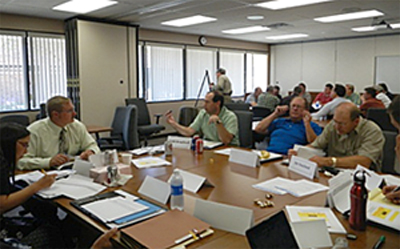
Staff from District 8, the Office of Freight and Commercial Vehicles and Customer Relations met with manufacturers from the around District 8 to learn about their experience with Minnesota’s transportation system. Photo by Judy Jacobs |
In 2013, District 8’s engineer and planners, along with staff from the offices of Freight and Commercial Vehicle Operations and Customer Relations, met with manufacturers about their experience with Minnesota’s transportation system. Specifically, they wanted to know what shippers’ and carriers’ transportation priorities are, what challenges they face and what MnDOT can do to better support their businesses and the economic health in the communities they are located.
The goal was to gather concrete, actionable information that could inform high-benefit/low-cost improvements to the infrastructure, operations, maintenance and communications during the next one-to-four years – improvements that manufacturers would experience and benefit from. In the process, MnDOT staff met with 75 manufacturers and carriers at plants across the district, interviewing them about their own experiences with the system, and helping them to solve problems, on-the-spot in some cases.
Manufacturing in District 8 includes small medical devices and electronics; precision, high-performance motors, drives and components; pre-fabricated enclosures and manufactured homes; heavy machinery; and significant livestock processing and food products. The majority of manufacturers interviewed, ship their products nationally and nearly half have international markets, including customers in China, Japan, Korea, India, Mexico and several countries in Europe.
The manufacturers’ input reflected some major themes and included specific requests for improvements along particular route segments. Manufacturers emphasized the need for:
- Smooth pavement for shipping fragile inputs, products, and sensitive livestock
- Wide shoulders for safety margins
- Plowing and other operations that provide for system reliability, enabling shippers and carriers to meet production and delivery schedules
- Signage and signaling that enhance safety and efficiency
- Advanced communication and planning for construction projects, detours and alternate routes
Shortly after the interviews, District 8 staff:
- Provided assistance to specific businesses regarding snow and ice operations and permitting
- Signed on additional manufacturers and carriers for email construction/winter road condition information
- Changed timelines for detour planning during construction season, from several months ahead to a year ahead, to gather input from manufacturers and shippers about specific route needs and give them more time to plan their alternate routes for the 2014 season
In addition, District 8 is currently reviewing interview information in the context of existing construction and maintenance plans, to align the program as much as possible with manufacturers’ concerns.
“Not only did we get great, concrete feedback from the interview process, but we built or strengthened relationships with manufacturers in the district” said Jon Huseby, District 8 engineer. “Now they know who they can call if they run into ‘roadblocks,’ and we can work with them proactively to head off potential problems around construction.”
The Operations Division plans to implement the Manufacturers’ Perspective model in all eight districts, to learn about, build relationships with, and address the needs of manufacturers throughout the state. District 4 will begin the project this summer.
For more information, check out the Manufacturers’ Perspectives report and on the District 8 website. |
 |
|

|
 |
TABLE of CONTENTS
 |
New website illustrates how transportation investments affect public |
|
MnDOT launched a new website for the public this week to better show the links between transportation, the economy and Minnesotans’ quality of life.
The Get Connected website was created in response to public feedback and provides answers to the most commonly asked financial questions the agency receives, such as: Where does the money for transportation come from? How is the money spent? What are MnDOT’s goals? What progress is MnDOT making toward these goals? How are projects selected?
“Minnesotans have a right to know how their tax dollars are being invested and to be confident that MnDOT is spending public money effectively on transportation,” said Tracy Hatch, deputy commissioner, chief financial officer and chief operating officer. "We designed this website specifically to meet our customers’ expectations.”
The site uses videos and other tools to engage users. For example, one video shows Hatch describing the different pots of money that provide funding for state transportation projects. In another, Mark Nelson, statewide planning and data analysis program manager, talks about how construction projects are selected. Others highlight some of MnDOT’s most innovative projects, such as the new Hwy 61 Hastings Bridge that was built on the banks of the Mississippi River, floated downriver and lifted into place.
In addition, the website has a “Transportation in the News” section that includes links to numerous articles about MnDOT’s work, along with a sampling of related articles that focus on infrastructure improvement needs of other states.
Visit www.mndot.gov/getconnected for more information.
|
 |
|

|
|

|
 |
TABLE of CONTENTS
 |
Three peregrine falcon chicks banded on Mississippi River Bridge in Wabasha |
By Mike Dougherty, District 6 public affairs coordinator
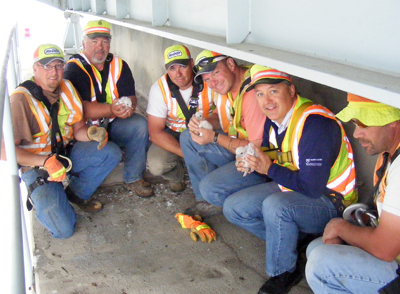
Pictured with the peregrine falcon chicks on the Hwy 60 Bridge in Wabasha are (from left) Mark Hovland, Larry Waletzki, Shane Eastman, and Tony Murilla, all from the District 6 Bridge Office; Mike Dougherty, District 6 public affairs, and Eric Patzner, District 6 Bridge Office. Photo courtesy of District 6 |
The District 6 Bridge Office assisted with the banding of three peregrine falcon chicks June 25 on the Michael Duane Clickner Memorial Bridge on Hwy 60 in Wabasha.
The chicks – two females and one male – were the first to be born in a nesting box placed by MnDOT on the bridge in 2009.
“It’s like waiting for your first kids,” said Larry Waletzki, District 6 East bridge maintenance supervisor.
The Bridge Office employees aided the Midwest Peregrine Society in reaching the box, so the chicks could be banded. Blood samples were also taken from the birds. The work was done in less than half an hour.
“The birds appeared healthy and well-fed,” said Jackie Fallon, Midwest Peregrine Society.
She said the chicks were approximately 15 days old. The eggs hatch after about 35 days and the chicks fledge about six weeks after hatching.
Both parents are banded. The mother is named Skeeter, who was born a year ago in John Latsch State Park north of Winona. The male is named Hedweg, a 2011 fledge from WPS Weston Power Plant near Rothschild, Wis.
The Midwest Peregrine Society asked MnDOT to name the chicks. The male was named Wally and the females were named Daytona and Kora Rose.
The falcons will continue to be monitored by volunteers of the peregrine society and spotters from the National Eagle Center in Wabasha.
MnDOT and its partners worked together on this project to gain the most value possible for the public. MnDOT also partners with the Midwest Peregrine Society elsewhere in Minnesota where falcons have nesting boxes on MnDOT structures.
“They’re a top-of-the-line predator, so they help keep the pigeons away from the bridge, which helps us with maintenance,” said Waletzki. |
 |
|
| |
|



